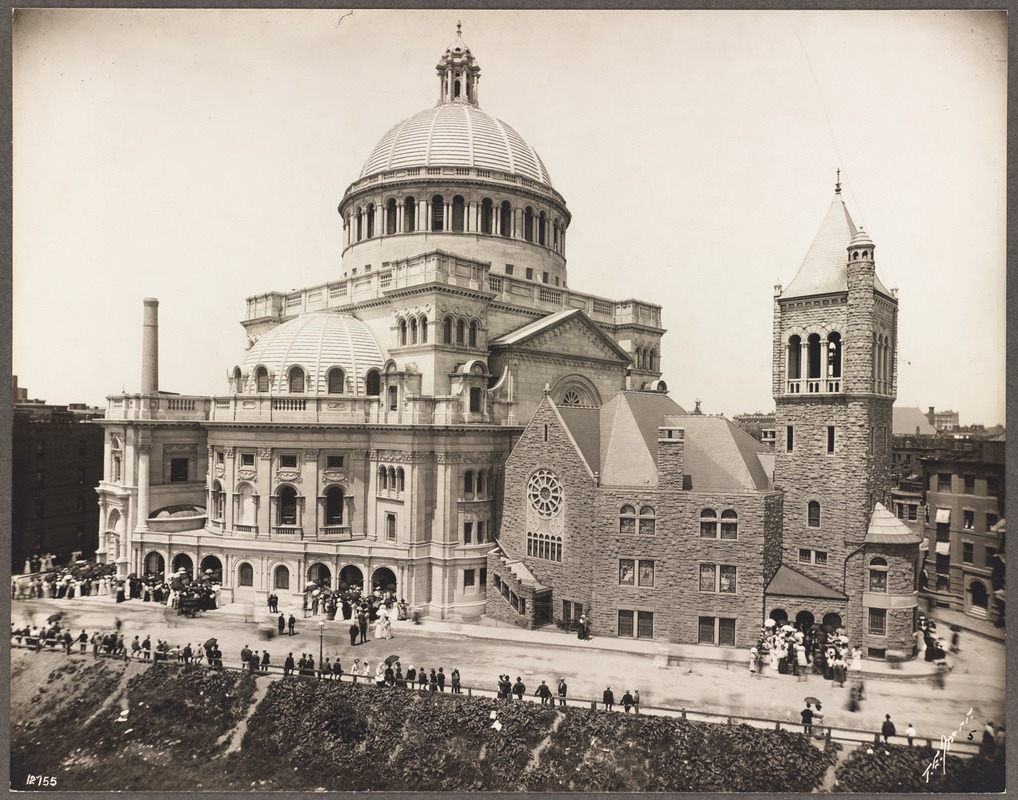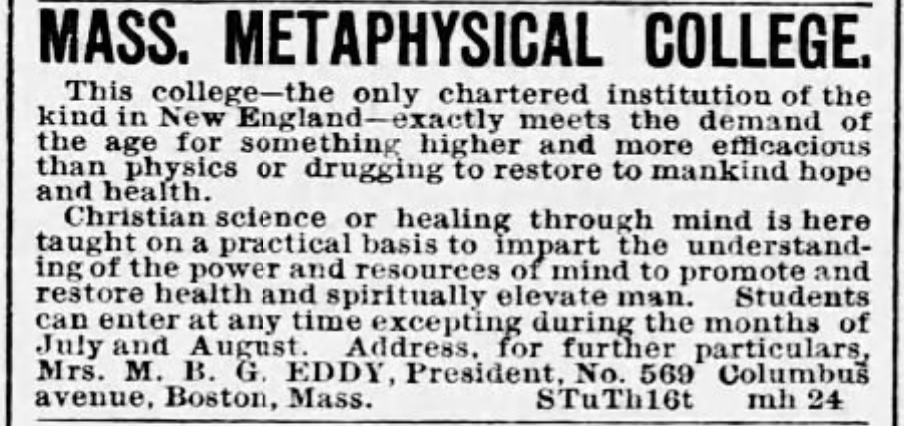Emma C. Shipman and the First Church of Christ, Scientist in the 1920 Women’s Voter Registrations
by Anna Boyles
New England religious leader Mary Baker Eddy oversaw the building of her new religion’s Mother Church on Huntington Avenue in Boston in 1894. Just sixteen years later, a massive extension to the church was added to the site to accommodate her new followers. Eddy’s First Church of Christ, Scientist, informally known as the Christian Science Church, was one of the fastest growing American religions during the first decades of the twentieth century, with thousands, many of whom were women, attracted to its metaphysical teachings. So far, the Mary Eliza transcription team has located ten women whose 1920 voter registration identifies their affiliation with the First Church of Christ, Scientist in Boston.
Mary Baker Eddy was born in New Hampshire in 1821, and faced much adversity through her life. She experienced hardships such as chronic illness and a fall in her 40s that led to her religious discovery. She had grown disillusioned with the medical systems of the day, and after consulting mentalist and mesmerist Phineas Quimby, Eddy began to believe that physical disease was caused by the human mind. As Eddy told her followers, she asked for a Bible after falling on an icy sidewalk and was miraculously cured from her injuries. Following years of scriptural study, Eddy eventually published her findings on the healing power of prayer through the love of Jesus Christ in her book, Science and Health with Key to the Scriptures, in 1875. Existing Christian churches were unreceptive to Eddy’s teachings, so she and twenty-six initial followers founded their own church in Lynn, Massachusetts in 1879. The First Church of Christ, Scientist’s stated purpose was to “reinstate primitive Christianity and its lost element of healing.”
By 1882, Eddy and her husband moved to Columbus Avenue in Boston. In her new neighborhood, the South End, she established the Massachusetts Metaphysical College, offering lessons to students in the parlor of her home. Eddy passed away in 1910, and while she did not live to see the passage of the 19th Amendment, she did write briefly on women’s suffrage in Science and Health: “Our laws are not impartial, to say the least, in their discrimination as to the person, property, and parental claims of the two sexes. If the elective franchise for women will remedy the evil without encouraging difficulties of greater magnitude, let us hope it will be granted.” Scholars debate how supportive Eddy was of women’s suffrage, or enfranchisement, but the church’s publications wrote throughout the era on the women’s rights and other social reform movements.
So far, the Mary Eliza team has found six women whose 1920 voter registration lists their place of employment as being at the Christian Science Publishing Company. These women were employed by the church as clerks, secretaries, and matrons. The Christian Science religion had grown to over 9,000 members across thirty-two states by 1890, and the church found it necessary to establish a publishing agency to produce and distribute periodicals containing literature and sermons. The publishing house was located in Boston near the Mother Church. Other women devoted their life to the Christian Science church while not formally employed by the institution. Mary Baker Eddy founded The First Church of Christ, Scientist as a lay church, meaning that there is no formal clergy. Followers of Christian Science, instead, could seek guidance from Christian Science Practitioners, who give “treatment” to individuals, largely focused on prayer. Practitioners’ names and contact information were printed by the Christian Science Publishing Company in the rear of their publications. A quick survey of a 1920 copy of the Christian Science Journal suggests that women held this important position in the Christian Science church in significant numbers.
One Christian Science Practitioner who registered to vote during the fall of 1920 was Emma C. Shipman. She was raised in Vermont, and reported witnessing two aunts perform healing on her family members when she was a girl. She entered Boston University’s College of Liberal Arts in 1892, and traveled to the Back Bay on Sundays to attend Christian Science services held in Chickering Hall and Copley Hall before the Mother Church was completed on Huntington Avenue. Shipman soon officially joined the First Church of Christ, Scientist, before completing lessons on Christian healing at Eddy’s Massachusetts Metaphysical College. She listed her services publicly as a Christian Science teacher in church publications beginning in 1899, offering healing and spiritual lessons out of her Back Bay home. During her lifetime, Shipman wrote over fifty articles for Christian Science periodicals, and at the age of seventy-eight, she was recognized for her dedication and leadership by being elected President of the Mother Church.
The First Church of Christ, Scientist, understood women as sources of knowledge and welcomed them into positions of authority early in the institution’s history. Boston and New England women were attracted in large numbers to the new religion, and their affiliation with the church can be found in some women’s voter registration records through their employment information. You can discover more Christian Scientists Practitioners and publishing house employees in the Women Voter Registers dataset. We have currently transcribed portions of the Back Bay, South End, Roxbury, East Boston, South Boston, and Dorchester, In addition, you can supplement your research using the digitized copies of the Christian Science Journal on HathiTrust.
For further reading:
Christian Science and a Woman's Right to Vote
Anna Boyles is a dual-degree student in History and Archives Management at Simmons University.






